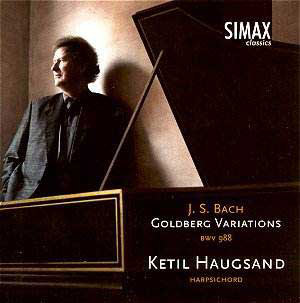Ketil Haugsand is a Norwegian harpsichordist who has recorded
several discs of music by Bach and by other baroque composers. He records
the Goldberg Variations here on a very interesting instrument,
a copy of an unsigned instrument found in Charlottenburg Castle in Berlin.
This harpsichord has a very bright sound, though almost too bright for
some; its treble end far outshines the midrange, though the bass is fairly
ample.
Haugsand approaches the Goldbergs as someone who wants
to have "fun". "I simply love the Goldbergs!" he
says in the notes. One can hear how he has fun from the very first bars
of the work. He adds far more ornaments than most harpsichordists. He
plays the work in a way similar to Ton Koopman, who also seems at home
with a more "French" approach, ornamenting as freely as Couperin.
This can be seen, for example, in the ninth variation, where Haugsand
introduces some almost Couperin-like trills into the repeats.
But this is not meant to be a criticism of his performance.
While this recording may not be for everyone, Haugsand is presenting
a personal vision of this work. While there is nothing revolutionary
in his performance, he never loses his enthusiasm. His ornamentation
gives the work a texture that many harpsichordists avoid, but his tempi
are never shocking, and always within the range of what is generally
considered to be normal.
He does stand out at times, such as in the thirteenth
variation, where his dotted rhythms jar a bit at first, but they end
up working well with the off-beat structure of certain parts of this
variation. He is lyrical in the longer, slower variations, such as the
15th and 25th. The former is an excellent study in how to ornament the
repeats to make them almost different works than the first parts. Haugsand
is creative and very interesting in his ornaments and subtle rhythmic
changes. However, in the latter, the longest of the thirty variations,
Haugsand’s approach to the complex rhythm does not seem convincing.
This is a shame, since this is the most profound of all the variations,
and, in a way, the heart of the work.
In the more virtuosic variations, such as the sixteenth,
the overture, Haugsand shows a marvellous command of his instrument,
never flaunting his skills, yet never letting the music get the better
of him. But in the seventeenth variation, he seems to lose sight of
the music behind the notes, and this part sounds too much like practice
and not enough like "fun".
When I listened to this recording the first time, I
began by feeling somewhat ambivalent; it seemed that Haugsand’s ornamentation
was a bit unusual. Of course, with a work this familiar, one always
has such feelings hearing differences. But as I listened to the work,
it grew on me, and I started to realize that Haugsand truly has a vision
of the Goldbergs that is unique and powerful. He plays with a spirit
that few harpsichordists have. This recording deserves to be up with
the best of the harpsichord Goldbergs. Ketil Haugsand has done what
too few harpsichordists have done: left his mark on this monument of
keyboard music. With the exception of his twenty-fifth variation, and
a couple of the faster variations, such as the seventeenth and twenty-sixth,
Haugsand’s judgement and technique shines through with both excellence
and great originality.
What a fine recording of the Goldberg Variations this
is! While it is not perfect, it is certainly one of the most personal
and original harpsichord recordings of this work to be released in years.
Aside from a few moments where the vision does not work - and a harsh
sounding instrument - this is one of the best harpsichord recordings
of this work.
Kirk McElhearn


